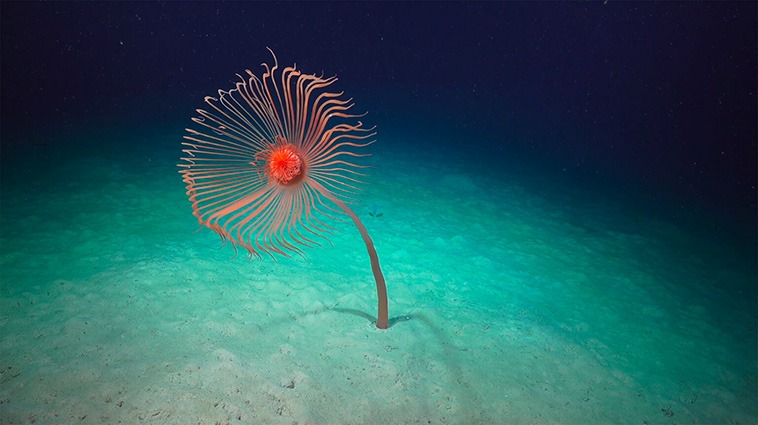ANIMALS
Surprise Visit from ‘World’s Most Dangerous Bird’ Startles Beach Visitors in Australia

In a video of the event, a big and unpredictable creature swam toward the shore, leaving onlookers puzzled about what it could be. At first sight, some thought it might be a turtle or a shark.
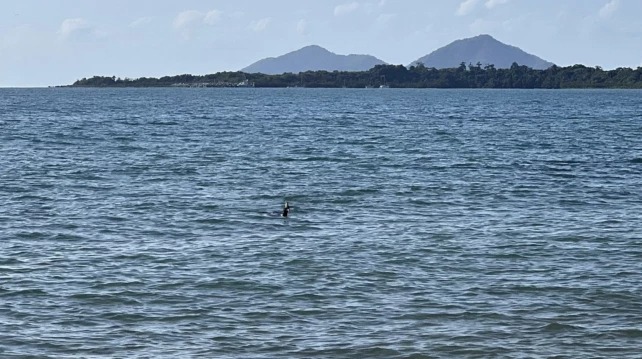 Image source: brisbanetimes
Image source: brisbanetimes
But as the unknown animal got closer to the shore, wildlife officials from the Queensland Department of Environment and Science identified it as a young cassowary.
Cassowaries are big, flightless birds that come from the rainforests of Queensland and Papua New Guinea.
These birds stand tall at about 6.5 feet and weigh around 167 pounds. They have a unique look, featuring a long, colorful neck, a helmet-like structure on their heads, and a dagger-shaped claw on their toes.
@brisbanetimes Australia, home of deadly swimming cassowaries. 👍 Video by Nikita McDowell via Environment Department #cassowary #cassowaries #aussieanimals #aussiewildlife #australiananimals ♬ original sound – brisbanetimes
Cassowaries are commonly known as “the world’s most dangerous bird” because of their large size, strength, sharp claws, and unpredictable behavior. Information from the Library of Congress suggests that predicting the bird’s actions can be difficult.
Stephen Clough, a wildlife officer from the Queensland Department of Environment and Science, explained that “cassowaries can swim and will take to the water to cross from one side of a river to the other, or if they feel threatened by domestic dogs or another cassowary through a territorial dispute.”
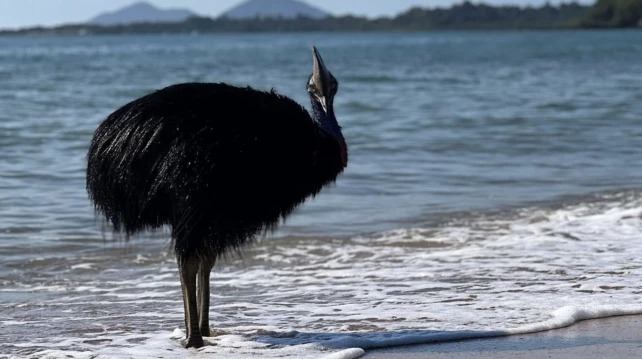 Image source: brisbanetimes
Image source: brisbanetimes
The exact reason for this cassowary’s swim in the ocean is still unknown. However, the footage capturing this unusual behavior has definitely surprised onlookers. Nikita McDowell, the campground’s host, filmed the cassowary’s “unexpected ocean swim,” according to officials.
In the video posted on social media, you can see the big bird smoothly floating on the waves. From a distance, only its head and neck are visible, making it look like a periscope.
 Image source: brisbanetimes
Image source: brisbanetimes
As the cassowary got closer to the shore, its complete brown-black body came into view, displaying its unique features. It has a head with a mohawk-like helmet structure, and hints of pink and blue coloring can be seen on its neck.
McDowell shared this scene, highlighting how the cassowary simply glided to the shore until its feet could touch the ground. Moreover, the cassowary seemed to glance at the camera multiple times, as shown in the video footage.
 Image source: brisbanetimes
Image source: brisbanetimes
Picture seeing the incredible sight of a cassowary unexpectedly going for a swim in the ocean, and then discovering it later resting under a tree, clearly tired.
Nikita McDowell explained that the bird stood in the shade with wobbly legs for around half an hour before disappearing mysteriously.
“I knew it wasn’t going to have the energy to attack me or anything,” she told the Australian Broadcasting Corp. “I am just so happy it’s moved on and is safe and healthy.”
Stephen Clough, a wildlife officer, added that “there’s an estimated 4,000 cassowaries remaining in Queensland, and they face numerous threats to their survival, including habitat loss, vehicle strikes, and domestic dog attacks.”
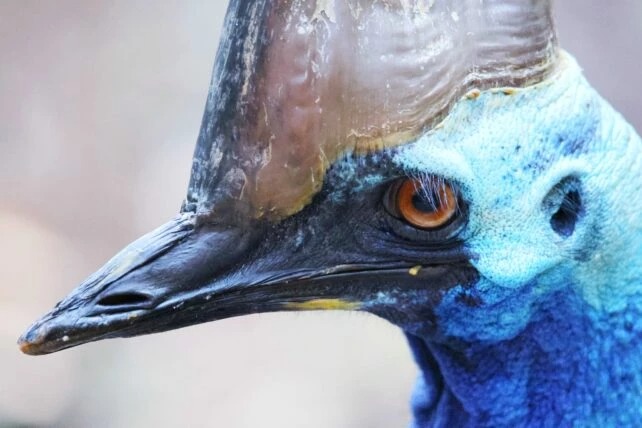 Image source: brisbanetimes
Image source: brisbanetimes
This uncommon experience reminds us of the importance of conservation efforts to safeguard these incredible birds.
ANIMALS
Amazing Video of Unseen Ocean Creatures in the Ningaloo Canyons

The Schmidt Ocean Institute recently explored the Ningaloo Canyons on the western coast of Australia using a robotic underwater vehicle called the ROV Sebastian. Check out the amazing video of what they discovered in the deep parts of the Indian Ocean.
More info: Youtube
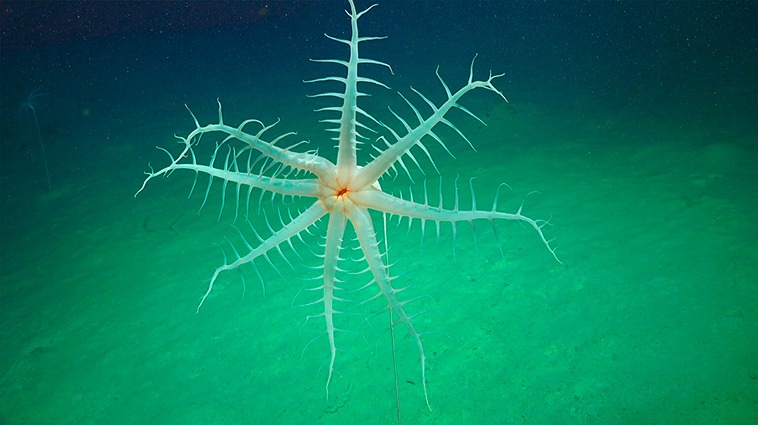
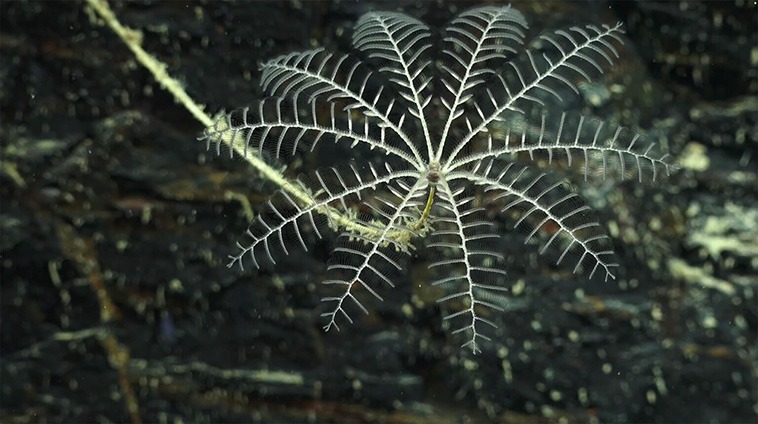


ANIMALS
These Pics Are Art and the Artists Are Insects

Flying insects move so quickly that they are hard to follow, but new technology and some smart ideas have helped Spanish photographer Xavi Bou do just that. After spending 10 years focusing on birds in flight for his Ornithographies project, he turned his attention to insects.
For Entomographies, he uses high-speed video footage taken by Adrian Smith, an insect expert at North Carolina State University, to study and record how insects move. Bou then picks multiple frames and combines them into single images that show the fast movements of one or more insects through space and time.
With Smith’s help, Bou has captured the aerial tricks of wasps, the jumps of leafhoppers, and the fluttering of butterflies in amazing detail. He hopes that by doing this, he can make people more aware of the decline in important insect populations around the world.
1. Zebra longwing
This butterfly, which is common in many areas of the Americas, really fits its name. It can fly very high with just a few flaps of its large wings.
 Image source: nationalgeographic
Image source: nationalgeographic
2. Two-lined spittlebug
This insect, which comes from the eastern United States, is often seen as a pest because it likes to eat grass. Its springy back legs can make it jump into the air like a rocket.
 Image source: nationalgeographic
Image source: nationalgeographic
3. Yellow-collared scape moth
Unlike most moths, this North American species flies during the day. Its shiny blue-black wings sparkle in the sunlight.
 Image source: nationalgeographic
Image source: nationalgeographic
4. Ailanthus webworm moths
These tropical moths have spread farther north in the U.S. Because of their larval host, the invasive tree of heaven, they are now one of the most common backyard moths in the country.
 Image source: nationalgeographic
Image source: nationalgeographic
5. Common stonefly
Mostly found in eastern North America, this insect starts its life as an underwater nymph in forested streams or rivers. Then it leaves the water, sheds its skin, and becomes an adult with wings.
 Image source: nationalgeographic
Image source: nationalgeographic
6. Green lacewings
Eighty-seven species of this insect have been found in the U.S. and Canada. Since they eat a lot of unwanted plant pests like aphids and mites, they are often used to naturally control these pests.
 Image source: nationalgeographic
Image source: nationalgeographic
7. Grapevine beetle
This insect, fittingly named, eats the leaves and fruit of grapevines, both wild and farmed, but it doesn’t do much damage to the plants. As a type of scarab beetle, it often flies in a curved path.
 Image source: nationalgeographic
Image source: nationalgeographic
8. Oak treehopper and green treehopper
Treehoppers are known for their uniquely shaped pronotum, the part behind their head, which often looks like plant parts to hide from predators. They can jump well thanks to special muscles.
 Image source: nationalgeographic
Image source: nationalgeographic
9. Banded orange
This brightly colored butterfly can be found from Mexico to Brazil. Before mating season, male butterflies look for mineral salts, sometimes even drinking salty fluids from the skin, eyes, and nostrils of other animals.
 Image source: nationalgeographic
Image source: nationalgeographic
10. Sapho longwing
Longwings can live for 6 to 7 months, longer than most butterflies. This type, found from Mexico to Ecuador, has shiny blue wings, which is why it’s also called the Sapphire longwing.
 Image source: nationalgeographic
Image source: nationalgeographic
ANIMALS
Eagle and Fox in an Epic Midair Battle Over a Rabbit, Were Captured by a Photographer

Wildlife photography often depends on the perfect combination of good timing and the right place.
That’s exactly what happened when Kevin Ebi, an experienced wildlife photographer, captured an incredible battle between a bald eagle and a red fox, both competing for a rabbit meal.
In a detailed blog post, Ebi shares the fascinating series of events that unfolded while he was photographing foxes in San Juan Island National Historical Park, located in Washington state.
Ebi noticed a lively group of eight fox kits as they began their hunting lessons. Suddenly, they spotted a rabbit, and a thrilling chase ensued. Eventually, one of the foxes emerged as the winner, proudly carrying the rabbit across the field.
 Image source: Kevin Ebi
Image source: Kevin Ebi
Ebi shares what happened at that moment: “As I followed the fox with my camera, a sudden bald eagle cry caught my attention. It was swiftly approaching, clearly aiming for the rabbit. I quickly focused on the fox, anticipating a quick turnover of events.”
To Ebi’s astonishment, instead of a quick surrender, the situation turned into a intense fight in the air.
The eagle used its power to lift the fox and rabbit high up in the sky. Even while airborne, the fox attempted to break free by swinging back and forth.
 Image source: Kevin Ebi
Image source: Kevin Ebi
 Image source: Kevin Ebi
Image source: Kevin Ebi
 Image source: Kevin Ebi
Image source: Kevin Ebi
In the end, the eagle moved the rabbit to its other claw, causing the fox to let go. The intense battle came to an end in less than 10 seconds.
 Image source: Kevin Ebi
Image source: Kevin Ebi
For those worried about the fox’s well-being after the fight, Ebi reassures that it was not injured. The fox swiftly bounced back from the encounter and resumed its playful behavior with the other young foxes, showing no visible wounds from the aerial clash.
 Image source: Kevin Ebi
Image source: Kevin Ebi
 Image source: Kevin Ebi
Image source: Kevin Ebi
 Image source: Kevin Ebi
Image source: Kevin Ebi
 Image source: Kevin Ebi
Image source: Kevin Ebi
-

 GARDEN12 tháng ago
GARDEN12 tháng ago4 Easiest Ways to Get Free Plants
-

 GARDEN9 tháng ago
GARDEN9 tháng ago15 Houseplants That Grow Well in Vases with Water
-

 FUNNY12 tháng ago
FUNNY12 tháng ago30 Weirdest Things That People Came Across On The Subway
-

 DIY & CRAFT11 tháng ago
DIY & CRAFT11 tháng ago19 Easy and Creative DIY Ideas to Enhance Front Yard
-

 FUNNY12 tháng ago
FUNNY12 tháng ago30 Funny and Perplexing Photos That Make You Laugh All Day
-

 ANIMALS12 tháng ago
ANIMALS12 tháng agoBritish Angler Caught Huge 67-Pound Goldfish in the World
-

 GARDEN10 tháng ago
GARDEN10 tháng ago30 Shimmering Side Yard Landscape Ideas
-

 FUNNY12 tháng ago
FUNNY12 tháng ago22 Design Fails That Will Make You Laugh Out Loud

